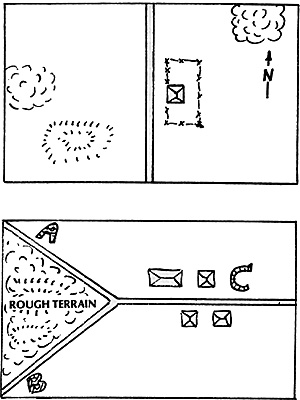Since The Courier is publishing ON TO RICHMOND I am inclosing this little piece with suggested Armies and two scenarios that have proved fun to play for us.
Union Army
I suggest a Corps of 9 Infantry Brigades of 6 stands each. We like four men to a stand and 1 stand with a mounted officer. Flagbearer etc. About 4 stands of Artillery in a Corps reserve or in divisional packets. 1 gun and a crew of 4 looks nice. Cavalry should be present but not in too large numbers. Six to eight stands in a brigade or at most 2 small (6 stand) brigades. This refers to mounted stands, we include dismounted alternates. Usually 4 dismounted stands for 6 mounted ones or 6 for 8. We also enjoy using a couple of stands of horseholders per brigade. it really adds to appearances.
Confederate Army
Again, Infantry in about 6 brigades but of 8 stands each. Artillery about the same amounts, usually the Union will have more guns and more rifled pieces. We suggest that you paint 2 guns for each stand. Don't attach them just paint 1 as a rif le and another as a Napoleon and simply mix per scenario need. Cavalry too as Union, but perhaps if the Rebs ever have a numerical advantage it should be here. We also paint up 1 casualty on a little stand per each brigade to use as a morale marker. Enjoy these scenarios.
PROBLEM #1
One side enters at point "A", the opponent at point "B". Their numbers and their orders should be as identical as possible. These orders being, to seize and hold point "C". Aggressive commanders sometimes attack over the rough ground or speed helter skelter toward the objective. It has the lovely advantage of being played over and over without repetition in what happens.
A word about troop strengths. The number of soldiers depends on several factors, for example:
-
1. size of board - always need a bigger one
2. time available - never enough
3. Complexity of rules - as a rule of thumb; as complexity goes up, size usually goes down.
4. number of troops - needless to say, never enough
5. scale of figures - the chief, indeed only, advantage of 15mm.
In this type of game, however, it iswise to keep both sides somewhat short handed. That is, that they cannot cover the entire march and still have men enough to seize the objective.
I sincerely recommend this game for it is intriguing and unusual. It actually duplicates the problems of advancing while exposing a flank... a common problem in history but never seen on the table top.
It all makes for uncertainty, thrills and the dreadful but necessary military quality of saving a disaster. What would "Stonewall" have done if Hooker had advanced?
One last quality is that this sort of game can be played repeatedly without boredom or repetition. Try it, it really is a lot of fun. Until then "Bugler sound the charge".
PROBLEM #2
The second type of scenario I would like to suggest is the out flanking opertation. The turning/flanking maneuver is the classic type of battle. From Cannae to Chancellorsville, the flank attack is King. Yet we never see it in miniatures, or almost never. The following system is set up to have both the dangers and thrills of the flanking march displayed.
At least 2 of these maps should be drawn up. Forces should be of medium size with the attacker having about a 10% edge in either numbers or quality.
Next, the defender marks his defensive position, on his map, facing north. While that is being done, the attacker marks on his own map, his march across the front of the defender. When completed the fun begins. Everything now depends on the results of 3 competitive die rolls:
| Attacker Wins | Defender Wins | Results |
|---|---|---|
| 3 | 0 | Defender places on board as on his map. Attacker lines up full on the flank of the defender, 3 inches from his end unit. |
| 2 | 1 | Same as above, but attacker must set up 6 inches from the edge of the board. |
| 1 | 2 | Attacker sets up 6 inches from side edge of board, but defender may then set up a new defense line facing it(battle fought lengthwise). |
| 0 | 3 | Attacker places his line of march across the board. Defender may set up 3 inches from him and hits his flank. |

Back to Table of Contents -- Courier Vol. III #6
To Courier List of Issues
To MagWeb Master Magazine List
© Copyright 1982 by The Courier Publishing Company.
This article appears in MagWeb (Magazine Web) on the Internet World Wide Web.
Other military history articles and gaming articles are available at http://www.magweb.com